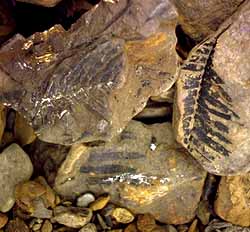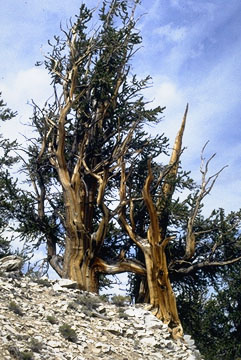Gymnosperms - an introduction
| The gymnosperms were the first seed plants and bear their ovules and seeds exposed on
the plant surface. This is in marked contrast to the more recent group of seed plants, the
flowering plants, which have their ovules sealed within the flower and their seeds
contained within a fruit. The name gymnosperm describes this feature. It literally means
naked seed. As should be clear to you by now, the plants we recognize as gymnosperms represent the sporophyte generation. |
| The Carboniferous was once called the "Age of Ferns" because of the numerous fossils with fern-like leaves found in coal and rock from this era (see right). It was only later noticed that these leaves also bore seeds and these plants were then termed "Seed Ferns". This is a misnomer. Ferns do not bear seeds. These plants were some of the earliest gymnosperms which have long been extinct. |  |
| The gymnosperms include the oldest and largest trees known. The Bristle Cone Pines, some over 4000 years old are the oldest living plants. The Giant Redwoods are over 100 m tall - the tallest plants known. Both are native to California. |
 |
|
| Bristle cone pines - the oldest trees |
Giant Redwoods - the tallest trees |
| In this course, we are going to look at the two main surviving groups of gymnosperms - the cycads and the conifers. If you would like to see some of the more unusual gymnosperms, take a virtual tour of the Gymnosperm Collection at the University of Georgia. |
| Now that
you have been introduced to the Gymnosperms, click the button to have a close look at the Cycads. |
![]() .
.